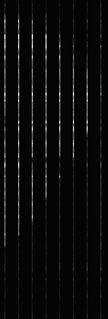| |
“REFLECT” is an interactive
audiovisual installation that experiments with the myth of Narcissus,
the reflection of one’s own face, perishable, impossible to
hold onto; seduced by the insinuation and seduction of a distorted
image that reminds us of ourselves. An image that requires the user
to intervene by exhaling on an interface, an action which is extinguished
in the same way.
“REFLECT” contrasts the physical experience of exhaling
with the digital experience of contemplating one’s own distorted
face.
The cover of the hardware consists of a chair which the user has
to sit on, a small screen facing the chair and welded to it, some
loudspeakers attached to the screen, a webcam, and a tube rising
up from the floor to just below the height of the screen. The user
takes part by blowing into the tube, in which there is a sensor
that sends information to an Arduino board. This board analyses
the signal and converts it into numerical values which it sends
to the computer to be processed by an application developed in Processing.
|
|
The webcam captures the user’s
face and sends the captured data to the computer where they are
analysed by the application developed in Processing.
Depending on the strength of the exhalation, the user’s distorted
face is reflected on the screen opposite them, so that the user
has to continue blowing in order for the image to remain there.
If they do not, it gradually fades away. The webcam capture is processed;
therefore what is seen on the screen is not what the camera captures.
It is not a “realistic” image as Processing distorts
the picture, breaking it up into a matrix of vertical and horizontal
elements which, seen as a whole, portray a subtle hint of the user’s
face. The black and white image plays with the light intensity in
relation to the strength of the exhalation, allowing each individual
to control the elements that make up the matrix.
The sound section works in conjunction with the visual section.
It appears and disappears according to the strength of the exhalation.
|
|
 |